|
|
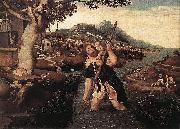 |
Jan Mostaert
|
|
(c. 1475 -1555/1556) was a Dutch painter of portraits and religious subjects, though his most famous creation was the "West Indies Landscape".
Although little is known of him, Mostaert was born and lived in Haarlem for most of his life. He worked as portraitist for Margaret of Austria, Regent of the Netherlands.
Much of his work was destroyed in the great fire of Haarlem in 1576, and some paintings once attributed to him are now attributed to Adriaen Isenbrant.
Mostaert was born in or about 1475 in Haarlem, Netherlands, to a famous noble family. Said to be handsome, eloquent and polite, Mostaert honed his craft under the guidance of Jacob van Haarlem, who may have actually been the anonymous "Master of the Brunswick Diptych". He is also said to be linked to the early Haarlem School of Painting. Mostaert's name first appeared in city records in 1498, the year he married and bought a house in his birthplace. He is also mentioned in Haarlem archives from 1527 to 1554. In 1500 Mostaert was commissioned to paint the shutters for a receptacle housing the relics of Saint Bavo in the Groote Kerk, Haarlem. From this date he began to be listed in the records of the Haarlem Guild of St. Luke, and continued to be frequently listed until 1549. He became deacon of the painters' guild in 1507, and again in 1543 and 1544.
His earliest works are noticeably influenced by Geertgen tot Sint Jans, an earlier Haarlem artist. Some believed that Mostaert was actually apprenticed to tot Sint Jans but it is doubtful that the artist had any apprentices or workshop assistants during his career. From tot Sint Jans, Mostaert adopted a refined style and thoughtful compositions for his works, as well as the stiff, angular look of his figures.
St. ChristopherBetween 1510 and 1516 Mostaert developed a delicate style where his doll-like figures inhabited bright, blue-skied landscapes, as for example in his "Adoration of the Magi" (c. 1510-15). His refined brushwork is precise, with an almost religious attention to detail. Also of note is the landscape, which demonstrates his leanings towards more romantic views with expansive hills. During the 1520s Mostaert was also influenced by Joachim Patinir's take on landscapes. Mostaert's "St. Christopher", a painting with a landscape that features a river receding into an expansive and hilly background, was once even attributed to Patinir.
Mostaert's portrait work of this earlier period includes a piece entitled "Portrait of Abel van den Coulster" (c. 1500-10), in which an elegant, thin-faced man is situated in equally elegant surroundings. Mostaert was known for copying original portraits for some of his courtly commissions but, as is the case with the "Portrait of Abel", he also painted figures from life and added aristocratic touches. He was known for presenting his portrait sitters in three-quarter-length and placing their hands on cushions. |
|
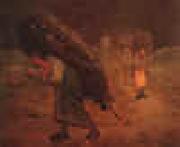 |
Jean Francois Millet
|
|
1814-1875
French
Jean Francois Millet Galleries
Millet was the first child of Jean-Louis-Nicolas and Aim??e-Henriette-Adelaide Henry Millet, members of the peasant community in the village of Gruchy, in Gr??ville-Hague (Normandy). Under the guidance of two village priests, Millet acquired a knowledge of Latin and modern authors, before being sent to Cherbourg in 1833 to study with a portrait painter named Paul Dumouchel. By 1835 he was studying full-time with Lucien-Th??ophile Langlois, a pupil of Baron Gros, in Cherbourg. A stipend provided by Langlois and others enabled Millet to move to Paris in 1837, where he studied at the Ecole des Beaux-Arts with Paul Delaroche. In 1839 his scholarship was terminated, and his first submission to the Salon was rejected.
After his first painting, a portrait, was accepted at the Salon of 1840, Millet returned to Cherbourg to begin a career as a portrait painter. However, the following year he married Pauline-Virginie Ono, and they moved to Paris. After rejections at the Salon of 1843 and Pauline's death by consumption, Millet returned again to Cherbourg. In 1845 Millet moved to Le Havre with Catherine Lemaire, whom he would marry in a civil ceremony in 1853; they would have nine children, and remain together for the rest of Millet's life. In Le Havre he painted portraits and small genre pieces for several months, before moving back to Paris.
It was in Paris in the middle 1840s that Millet befriended Constant Troyon, Narcisse Diaz, Charles Jacque, and Theodore Rousseau, artists who, like Millet, would become associated with the Barbizon school; Honor?? Daumier, whose figure draftsmanship would influence Millet's subsequent rendering of peasant subjects; and Alfred Sensier, a government bureaucrat who would become a lifelong supporter and eventually the artist's biographer. In 1847 his first Salon success came with the exhibition of a painting Oedipus Taken down from the Tree, and in 1848 his Winnower was bought by the government. |
|
|
|
|
|
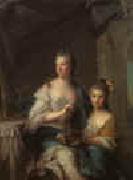 |
Jean Marc Nattier
|
|
1685-1766
French
Jean Marc Nattier Gallery
Brother of Jean-Baptiste Nattier. As well as being taught by his father, he trained with his godfather, Jean Jouvenet, and attended the drawing classes of the Academie Royale, where in 1700 he won the Premier Prix de Dessin. From around 1703 he worked on La Galerie du Palais du Luxembourg. The experience of copying the work of Rubens does not, however, seem to have had a liberating effect on his draughtsmanship, which was described by the 18th-century collector Pierre-Jean Mariette as cold. Nattier was commissioned to make further drawings for engravers in the early part of his career, including those after Hyacinthe Rigaud famous state portrait of Louis XIV (1701; Paris, Louvre) in 1710, which indicates that he had established a reputation while he was still quite young. Although he was offered a place at the Academie de France in Rome on the recommendation of Jouvenet, Nattier preferred to remain in Paris and further his career. In 1717 he nevertheless made a trip to Holland, where he painted portraits of Peter the Great and the Empress Catherine (St Petersburg, Hermitage). The Tsar offered Nattier work at the Russian court, but the artist declined the offer. He remained in Paris for the rest of his life. |
|
|
|
 |
Jean-Baptiste Monnoyer
|
|
(12 January 1636 - 20 February 1699) was a Franco-Flemish painter who specialised in flower pieces. He was attached to the Gobelins tapestry workshops and the Beauvais tapestry workshops, too, where he produced cartoons of fruit and flowers for the tapestry-weavers, and at Beauvais was one of three painterswho collaborated to produce cartoons for the suite The Emperor of China.
He was born at Lille, but was in Paris by 1650, where he was documented working on the decors of the Hôtel Lambert. He was taken up by Charles Le Brun for decorative painting at the Château de Marly and at the Grand Dauphin's residence, the Château de Meudon. He was received at the Academie Royale de Peinture et de Sculpture in 1665 with a piece of the genre that he made his specialty, a still life of flowers and fruit combined with objets d'art. His only appearance at the Paris salon was in 1673. |
|
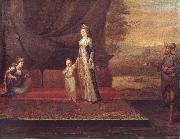 |
Jean-Baptiste Van Mour
|
|
17th Century Painters of the Bosporus,was a Flemish-French painter, remembered for his detailed portrayal of life in the Ottoman Empire during the Tulip Era and the rule of Sultan Ahmed III. Van Mour was a native of Valenciennes, a Flemish town that at he time of his birth belonged to the Spanish Netherlands, but since 1678 to France. He studied art in the studio of Jacques-Albert Gerin, and his work attracted the attention of an aristocrat and statesman of the time, Marquis Charles de Ferriol. Van Mour was invited to go to Istanbul when De Ferriol was appointed there as the French Ambassador in 1699. De Ferriol commissioned van Mour to do one hundred portraits of the local people. In 1711 De Ferriol returned to France and van Mour worked for a variety of other diplomats. In the meantime De Ferriol published a series of one hundred engravings (after the paintings) in Recueil de cent estampes representant differentes nations du Levant. The book had a great influence in Western Europe and was published in at least five languages. Painting audiences with the Sultan became van Mour's speciality; he only had to change the setting and a few faces. Van Mour worked with assistants to fulfill all his obligations. In 1725 he was granted the extraordinary title of Peintre Ordinaire du Roy en Levant in recognition of both his and the Levant's importance to the French government. In 1727 the Dutch ambassador Cornelis Calkoen asked Van Mour to record his audience with Sultan Ahmed III on canvas. Van Mour was allowed to enter the palace during these ceremonies accompanying the ambassador and his retinue; therefore, he was familiar with the special protocol that prevailed in the Ottoman court for ambassador's receptions. Calkoen took many paintings of Jean-Baptiste van Mour with him, when he was appointed as ambassador in Dresden for the Dutch Republic. In his will of 1762 the bachelor Calkoen forbade his heirs to sell the paintings, which are now part of the Rijksmuseum collection. |
|
|
|
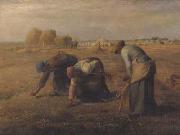 |
jean-francois millet
|
|
French Realist Painter, 1814-1875
.was a French painter and one of the founders of the Barbizon school in rural France. Millet is noted for his scenes of peasant farmers; he can be categorized as part of the naturalism and realism movements. |
|
|
|
|
|
 |
Jean-Louis-Ernest Meissonier
|
|
French Academic Painter, 1815-1891,French painter, sculptor and illustrator. Although he was briefly a student of Jules Potier (1796-1865) and Leon Cogniet, Meissonier was mainly self-taught and gained experience by designing wood-engravings for book illustrations. These included Leon Curmer's celebrated edition of J.-H. Bernardin de Saint-Pierre's Paul et Virginie (Paris, 1838), the series Les Franeais peints par eux-memes (Paris, 1840-42) and Louis de Chevigne's Les Contes remois (Paris, 1858). |
|
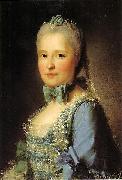 |
Jean-Martial Fredou
|
|
Jean-Martial Fredou (28 January 1710 e 1795) was a French painter known for his portraits.
Born at Fontenay-Saint-Pere, Fredou was attached to the Cabinet du Roi housed in the Hôtel de la Surintendance at Versailles, where he was commissioned to render duplicates of official portraits of the French royal family painted by Jean-Marc Nattier, Maurice Quentin de La Tour, Louis-Michel Van Loo, Alexander Roslin or Joseph Siffred Duplessis.
In his own commissions he often borrowed elements from the original works of these painters, for he was a deft portraitist himself. Between 1760 and 1762 the dauphine Marie-Josephe de Saxe, daughter-in-law of Louis XV commissioned informal portraits of herself and her children, for her own use. These portraits, whether in oil or drawn aux trois crayons, touched with pastels, have freshness and life.
A modest commission came from the Dauphin and Dauphine in 1757: in 1748 they had earth brought in to the little courtyard of their private apartments at the château de Versailles, closed in with trelliswork, to make a little garden; and Fredou was commissiomed to paint two perspective panels to enlarge the little space.[1]
Fredou was never made a member of the Academie Royale de Peinture et de Sculpture, but he was made First Painter to the comte de Provence in 1776 upon the death of François-Hubert Drouais.
|
|
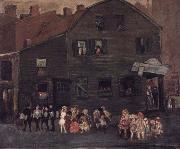 |
Jerome Myers
|
|
(March 20, 1867 - June 19, 1940) was a U.S. artist and writer. Born in Petersburg, Virginia and raised in Philadelphia, Trenton and Baltimore, he spent his adult life in New York City. Jerome worked briefly as an actor and scene painter, then studied art at Cooper Union and the Art Students League where his main teacher was George de Forest Brush. In 1896 and 1914, he was in Paris, but his main classroom was the streets of New York's lower East Side. His strong interest and feelings for the new immigrants and their life resulted in hundreds of drawings, as well as paintings and etchings capturing the whole panorama of their lives as found outside of the crowded tenements which were their first homes in America. |
|
|
|
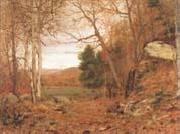 |
Jervis Mcentee
|
|
American Realist Painter, 1828-1891, He was an American painter of the Hudson River School. He is a somewhat lesser-known figure of the 19th century American art world, but was the close friend and traveling companion of several of the important Hudson River School artists. Aside from his paintings, McEntee's enduring legacy are the detailed journals he kept from the early 1870s until his death. In his writings McEntee records a detailed account of Hudson River School artists, their day-to-day life, gossip and personal reflections, and the overall arc of the American art world in the second half of the 19th century. He discusses his artistic successes and trials, particularly as money becomes more scarce with the decline in popularity of Hudson River School art. McEntee's journals are now kept by the Archives of American Art, a research center within the Smithsonian Institution. Five volumes of these diaries, from 1872 to 1890, have been digitally scanned, transcribed, and can be browsed in their entirety in the Jervis McEntee Diaries Online. McEntee was born in Rondout, New York on July 14, 1828. Little is known of his childhood. He exhibited his first painting at the National Academy of Design in New York City in 1850. |
|
 |
Jessie Marion King
|
|
1875-1949,was a Scottish painter and illustrator of Children's books. She was married to E. A. Taylor. She was born in Bearsden, near Glasgow. Her father was a minister with the Church of Scotland and she received a strict religious education and was discouraged from becoming an artist. Jessie M. King began training as an Art teacher in 1891 at Queen Margaret??s College. In 1892 she entered the Glasgow School of Art. As a student, she received a number of awards, including her first silver medal from the National Competition, South Kensington (1898). King was made Tutor in Book Decoration and Design at Glasgow School of Art in 1899. Her first published designs, and some people believe her finest, were for the covers of books published by Globus Verlag, Berlin between 1899 and 1902. The publisher was a subsidiary company of the great Berlin department store, Wertheim's. She was influenced by the Art Nouveau of the period and her works juxtaposed in mood with that of The Glasgow Four. She made a Grand Tour of Germany and Italy in 1902 and was influenced by the works of Botticelli. In the same year her binding for "L'Evangile de L'Enfance" was awarded a gold medal in the International Exhibition of Modern Decorative Art, held in Turin. King became a committee member of the Glasgow Society of Artists (1903) and a member of the Glasgow Society of Lady Artists (1905). Her contribution to Art Nouveau peaked during her first exhibitions, Annan's Gallery in Glasgow (1907) and Bruton Street Galleries, London (1905). She married E. A. Taylor in 1907 and moved with him to Salford. In 1910 they moved on to Paris where Taylor had gained a professorship at Tudor Hart's Studios. |
|
|
|
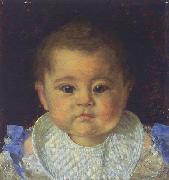 |
Joanna Mary Boyce
|
|
Joanna Mary Boyce, also known as Mrs. H. T. Wells, her married name, (7 December 1831 - 15 July 1861) was an English painter of portraits, genre pictures, and occasionally landscapes. She was the sister of pre-Raphaelite watercolorist George Price Boyce, and was herself associated with the Brotherhood.
|
|
|
|
 |
Johann Georg Meyer
|
|
Johann Georg Meyer (28 October 1813 Bremen, Germany - 4 December 1886 Berlin), commonly known as Meyer von Bremen, was a German painter who specialized in Biblical, peasant, and family scenes.
In his 2lst year, he went to Desseldorf and began his studies at the Academy of Art there, which was led by Friedrich Wilhelm Schadow, the son of sculptor Johann Gottfried Schadow. In 1841, Meyer opened a studio of his own, but moved to Berlin as his fame increased (1853). While scenes from the Bible were first the subjects of his brush, he later turned his attention to incidents from popular life, especially among the Hessian peasantry, and finally to the portrayal of family life in its pathetic aspect. Such pictures as eThe Jubilee of a Hessian Pastore (1843), hristmas Eve,e eBlindman's Buff,e eThe Soldier's Return,e eThe Inundatione (1846), eThe Repentant Daughtere (1852, in the gallery at Bremen), are full of intense sympathy with the esimple annals of the poor.e After taking up his residence at Berlin, he chose especially scenes from child life, which he rendered with spirited humor. Among his pictures of this kind are eThe Fairy Tale,ehildren Playing Blindman's Buff,e eGrandfather and Grandchild,e and others. A third group of his pictures includes those of young women, as single figures or in groups, such as eThe Tryste and eThe Love Letter.e An example of his work, eThe Lettere (1873), is in the Metropolitan Museum of Art in New York City. |
|
 |
Johann Jakob Meyer
|
|
b Winterthur, 7 Oct 1763; d Aussersihl, Schwyz, 10 April 1830,Swiss painter and engraver. He studied under Johann Rudolf Schellenburg in Winterthur and then, in 1778, with Heinrich Rieter (1751-1818) in Berne, where he was also influenced by the topographical landscapes of Johann Ludwig Aberli. He was adept at executing such sharply detailed engravings of Swiss cities as View of Lucerne (c. 1790; e.g. Lucerne, Zentbib.), which he sold to tourists. In 1802 he published an important series of views of Switzerland, which were widely circulated. His skill as a painter of animals was sometimes combined with his rendering of the landscape, as in View of the Lake of Bienne (c. 1800; Winterthur, Kstmus.). In 1807 he taught drawing in Basle and in 1814 was active in the area around Lake Constance. His paintings are often characterized by warm colours and frequently capture the atmosphere of late afternoon, as in Murg on the Lake of Walen (c. 1820; St Gall, Kstmus.). Many of his landscapes are straightforward depictions of the Swiss countryside, stressing the romantic nature of the scene, as in View of the Area of Bex (1821; Winterthur, Kstmus.). He painted in Zurich in 1827 and was known to have travelled to Munich and Dresden. His works are important visual documents of an image of the pastoral countryside frequently propagated by Swiss artists in accordance with the philosophical ideals of Jean-Jacques Rousseau |
|
|
|
|
|
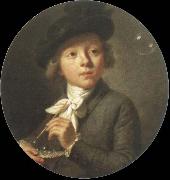 |
johann melchior wyrsch
|
|
johann melchior wyrsch (1732-98) was born in buochs, switzerland. in 1753 he went to rome to study with gaetano lapis and then at the academie francaise. |
|
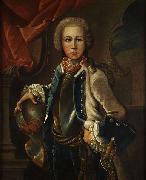 |
Johann Michael Franz
|
|
Seine Eltern waren der Zimmermeister Jakob Franz , und Anna geb. Lueger. Seine Ausbildung genoss er im Umkreis des Augsburger Reichsstädtischen Kunstakademiedirektors Johann Georg Bergmuller (Bergmiller) (1688-1762); nach eigenen Angaben schloss er sie 1733 ab. |
|
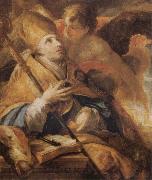 |
Johann Michael Rottmayr
|
|
Austrian,1654-1730
Austrian painter and draughtsman. He is most notable for large-scale religious and secular decorative schemes, and his career heralded the important 18th-century German contribution to late Baroque and Rococo fresco painting. He was probably taught by his mother, who was a painter of wooden sculpture. Between 1675 and 1687-8 he was in Venice as a pupil and assistant of the Munich artist Johann Carl Loth, whose studio attracted many painters from Austria and southern Germany. It is possible that Rottmayr also visited other Italian cities, in particular Bologna and Rome. He returned to Salzburg in the late 1680s a mature painter and immediately received commissions for panels and frescoes. In 1689 he painted mythological scenes for the Karabinierisaal at the Residenz in Salzburg (in situ); in composition and style these are close to high Baroque models, particularly the work of Pietro da Cortona and Peter Paul Rubens. Such models, as well as the example of Loth, and Venetian painting, had an important influence on Rottmayr's panel paintings of this period, for example the Sacrifice of Iphigenia (c. 1691; Vienna, Belvedere) or St Agnes (1693-5) and St Sebastian (1694; both Passau, Cathedral). In these, the solidity of the figures is emphasized through the use of intense colours. For Rottmayr, however, the rational development of the figures and the composition was less important than the overall effect achieved by the use of colour. Incorrect details of anatomy and perspective found compensation in greater expressiveness, mainly conveyed by gesture and pose. Rottmayr's images are filled with plastic elements, creating a staccato effect. Several very important early commissions paved the way for Rottmayr's move to Vienna in the late 1690s. |
|
 |
Johann Michael Sattler
|
|
(28 September 1786, Herzogenburg, Lower Austria - 28 September 1847, Mattsee, Salzburg) was an Austrian portrait and landscape painter, best known for his large-scale panoramas.
Sattler attended the Vienna Academy beginning in 1804 under the tutelage of Hubert Maurer. In 1819 Sattler moved to Salzburg, where in 1824 he began to paint a 360-degree panorama of the city as seen from the top of Salzburg's castle. The massive work covered 125 square metres and was first exhibited in 1829. Salzburg made him an honorary resident. Stattler toured across Europe with the painting for ten years, writing about his return in 1838, "with 30 tons and crossing approximately 30,000 kilometres of land and water, a feat no one had ever done before me and one which would be difficult to repeat in the future." Satler's son, the artist Hubert Sattler, donated the work to the city in 1870. The painting is now on display at the Salzburg Museum in a specially designed area called the Panorama Museum. |
|
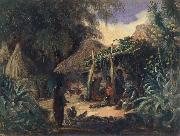 |
Johann Moritz Rugendas
|
|
Augsburg 1802-1858 Weilheim an der Teck,was a German painter, famous for his works depicting landscapes and ethnographic subjects in several countries in the Americas, in the first half of the 19th century. Rugendas was born to the seventh generation of a family of noted painters and engravers of Augsburg (he was a grandson of Georg Philipp Rugendas, 1666-1742, a celebrated painter of battles), and studied drawing and engraving with his father, Johann Lorenz Rugendas II (1775-1826). From 1815 to 1817 he studied with Albrecht Adam (1786-1862), and later in the Academy de Arts of Munich, with Lorenzo Quaglio II (1793-1869). Inspired by the artistic work of Thomas Ender (1793-1875) and the travel accounts in the tropics by Austrian naturalists Johann Baptist von Spix (1781-1826) and Carl von Martius (1794-1868), Rugendas arrived in Brazil in 1821, where he was soon hired as an illustrator for Baron von Langsdorff's scientific expedition to Minas Gerais and Sao Paulo. Langsdorff was the consul-general of the Russian Empire in Brazil and had a farm in the northern region of Rio de Janeiro, where Rugendas went to live with other members of the expedition. In this capacity, Rugendas visited the Serra da Mantiqueira and the historical towns of Barbacena, Sao Joao del Rei, Mariana, Ouro Preto, Caete, Sabara and Santa Luzia. |
|
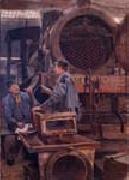 |
Johannes Martini
|
|
(9 June 1866 C 7 February 1935) was a German oil painter and graphic artist.
Martini was born in Chemnitz, Saxony. He was a student of Franz Skarbina at the Akademie der Kenste of Berlin, and he spent two years at the Acad??mie Julian in Paris. Martini exhibited his work at the Great Art Exhibition in Berlin and the Paris Salon. He participated in the jubilee exhibit for the 90th birthday of Luitpold of Bavaria, as well as the Annual Exhibition in Berlin's Glass Palace. |
|
|
|
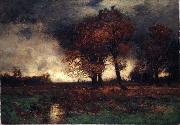 |
John Francis Murphy
|
|
(December 11, 1853 - January 30, 1921), American landscape painter.
He was born at Oswego, New York and first exhibited at the National Academy of Design in 1876, and was made an associate in 1885 and a full academician two years later. He became a member of the Society of American Artists (1901) and of the American Watercolor Society. At first influenced by Wyant and Inness, after 1900 he attacked the modern problems of light and air, thus combining the old and new theories of landscape painting. His chief characteristics are extreme refinement and charm, poetic sentiment, and beauty of surface. His composition is simple and his rendering of soil unique. A past master of values, he preferred the quiet and subdued aspects of nature. He received numerous awards, including a gold medal at Charleston (1902) and the Inness medal in 1910. |
|
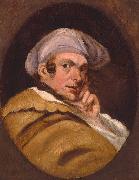 |
John Hamilton Mortimer
|
|
ARA (1740-1779) was a British Neoclassical figure and landscape painter and printmaker, known for romantic paintings set in Italy, works depicting conversations, and works drawn in the 1770s portraying war scenes, similar to those of Salvator Rosa.
Mortimer became President of the Society of Artists in 1774, five years before his death, at age 39.
John Hamilton Mortimer was born on 17 September 1740 at Eastbourne. Not much is known about his family, other than that his father was a customs officer, a dealer in flour and owner of several mills. By 1757, while he was still young, he was studying in London at the Duke of Richmond's Academy. During this time he became a friend of Joseph Wright, a fellow student at the Academy - a friendship which would endure throughout Mortimer's life. Mortimer is also known to have had some professional relationship with the artist Samuel Ireland, who was involved with etching Mortimer's work. At the St Martin's Lane Academy his fellow students included Thomas Jones and William Pars. In 1759 Mortimer won a first prize for a study after Michelangelo's Bacchus and a second prize for a life drawing.
He began to display his works on a regular basis from the early 1760s onwards. He became an active member of the Society of Artists and President of the Society in 1774. |
|
|
|
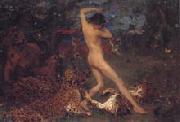 |
John Macallan Swan
|
|
British Academic Painter, 1847-1910
was an English painter and sculptor. John Macallan Swan was born in Brentford, Middlesex in 1847. He received his art training first in England at the Worcester and Lambeth schools of art and the Royal Academy schools, and subsequently in Paris, in the studios of Jean-L??on G??rôme and Emmanuel Fr??miet. He began to exhibit at the Academy in 1878, and was elected associate in 1894 and academician in 1905. He was appointed a member of the Dutch Water-Colour Society in 1885; and associate of the Royal Society of Painters in Water Colours in 1896 and full member in 1899. A master of the oil, water-colour and pastel mediums, an accomplished painter and a skilful draughtsman, he ranks also as a sculptor of distinguished ability. He has treated the human figure with notable power, but it is by his representations of the larger wild animals, mainly the felidae, that he chiefly established his reputation; in this branch of practice he has scarcely a rival. His picture "The Prodigal Son," bought for the Chantrey collection in 1889, is in the National Gallery of British Art. |
|
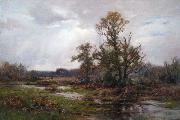 |
John MacWhirter
|
|
(27 March 1839 Slateford, Water of Leith - 28 January 1911 London) was a Scottish landscape painter.
John was the third of four children. He attended a school in Colinton, and after his father's death was apprenticed to Oliver & Boyd, booksellers in Edinburgh. He stayed there for only a few months and then in 1851 enrolled at the Trustees Academy under Robert Scott Lauder and John Ballantyne (1815-97). He spent long periods sketching and studying nature outdoors. His first painting to be exhibited at the Royal Scottish Academy at age 14, was 'Old Cottage at Braid'. In 1880, he was made an Honorary Member of the Royal Scottish Academy. Exploring and painting abroad he visited Italy, Sicily, Switzerland, Austria, Turkey, Norway and the U.S.A. - the Alps being a great inspiration. He moved to London in 1867 and on 4 May 1893 was elected a Royal Academician.
MacWhirter specialised in romantic landscapes with a great fondness for trees, spending much time in the hilly countryside of Perthshire. Initially, under the influence of John Everett Millais, he experimented with the detailed images of the Pre-Raphaelites, but later adopted a more sweeping style. With John Pettie he illustrated The Postman's Bag (Strahan, 1862), and Wordsworth's Poetry for the Young (Strahan, 1863). |
|
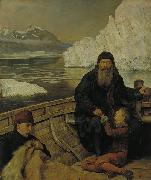 |
John Maler Collier
|
|
(27 January 1850 - 11 April 1934), called 'Jack' by his family and friends, was a leading English artist, and an author. He painted in the Pre-Raphaelite style, and was one of the most prominent portrait painters of his generation. Both his marriages were to daughters of Thomas Henry Huxley. He studied painting at the Munich Academy where he enrolled on 14 April 1875 (Register: 3145) at the age of 25.
Collier was from a talented and successful family. His grandfather, John Collier, was a Quaker merchant who became a Member of Parliament. His father (who was a Member of Parliament, Attorney General and, for many years, a full-time judge of the Privy Council) was created the first Lord Monkswell. He was also a member of the Royal Society of British Artists. John Collier's elder brother, the second Lord Monkswell, was Under-Secretary of State for War and Chairman of the London County Council.
Collier's first wife, Marian Huxley, 1883In due course, Collier became an integral part of the family of Thomas Henry Huxley PC, sometime President of the Royal Society. Collier married two of Huxley's daughters and was "on terms of intimate friendship" with his son, the writer Leonard Huxley. Collier's first wife, in 1879, was Marian (Mady) Huxley. She was a painter who studied, like her husband, at the Slade and exhibited at the Royal Academy and elsewhere. After the birth of their only child, a daughter, she suffered severe post-natal depression and was taken to Paris for treatment where, however, she contracted pneumonia and died in 1887.
In 1889 Collier married Mady's younger sister Ethel Huxley. Until the Deceased Wife's Sister's Marriage Act 1907 such a marriage was not possible in England, so the ceremony took place in Norway. Collier's daughter by his first marriage, Joyce, was a portrait miniaturist, and a member of the Royal Society of Miniature Painters. By his second wife he had a daughter and a son, Sir Laurence Collier KCMG, who was the British Ambassador to Norway 1941-51.
|
|
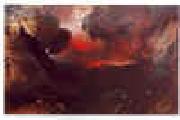 |
John Martin
|
|
British
1789-1854
John Martin Gallery
His first exhibited subject picture, Sadak in Search of the Waters of Oblivion (now in the St. Louis Art Museum), was hung in the Ante-room of the Royal Academy in 1812, and sold for fifty guineas. It was followed by the Expulsion (1813), Paradise (1813), Clytie (1814), and Joshua Commanding the Sun to Stand Still upon Gibeon (1816). In 1821 appeared his Belshazzar's Feast, which excited much favorable and hostile comment, and was awarded a prize of £200 at the British Institution, where the Joshua had previously carried off a premium of £100. Then came the Destruction of Herculaneum (1822), the Creation (1824), the Eve of the Deluge (1841), and a series of other Biblical and imaginative subjects. The Plains of Heaven is thought to reflect his memories of the Allendale of his youth.
Martin's large paintings were inspired by "contemporary dioramas or panoramas, popular entertainments in which large painted cloths were displayed, and animated by the skilful use of artificial light. Martin has often been claimed as a forerunner of the epic cinema, and there is no doubt that the pioneer director D. W. Griffith was aware of his work." In turn, the diorama makers borrowed Martin's work, to the point of plagiarism. A 2000-square-foot version of Belshazzar's Feast was mounted at a facility called the British Diorama in 1833; Martin tried, but failed, to shut down the display with a court order. Another diorama of the same picture was staged in New York City in 1835. These dioramas were tremendous successes with their audiences, but wounded Martin's reputation in the serious art world. |
|
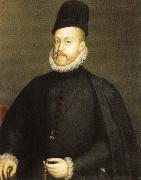 |
john masefield
|
|
(born June 1, 1878, Ledbury, Herefordshire, Eng. ?? died May 12, 1967, near Abingdon, Berkshire) English poet. He went to sea in his youth, then lived precariously for several years in the U.S. before settling in London. He is best known for his poems of the sea, Salt-Water Ballads (1902, including "Sea Fever" and "Cargoes"), and for his long narrative poems, such as The Everlasting Mercy (1911), containing phrases of colloquial coarseness that were unknown in earlier 20th-century English verse. After he became poet laureate in 1930, his poetry became more austere. He also wrote adventure novels, sketches, and works for children.
|
|
|
|
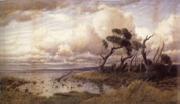 |
John Mather
|
|
Australian painter, etcher and teacher.
1848-1916
|
|
|
|
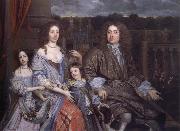 |
John Michael Wright
|
|
English Baroque Era Painter, ca.1617-1694,was a British baroque portrait painter. Wright trained in Edinburgh under the Scots painter George Jamesone, and acquired a considerable reputation as an artist and scholar during a long sojourn in Rome. There he was admitted to the Accademia di San Luca, and was associated with some of the leading artists of his generation. He was engaged by Archduke Leopold Wilhelm of Austria, the governor of the Spanish Netherlands, to acquire artworks in Oliver Cromwell's England in 1655. He took up permanent residence in England from 1656, and served as court painter before and after the English Restoration. A convert to Roman Catholicism, he was a favourite of the restored Stuart court, a client of both Charles II and James II, and was a witness to many of the political manoeuvrings of the era. In the final years of the Stuart monarchy he returned to Rome as part of an embassy to Pope Innocent XI. Wright is currently rated as one of the leading indigenous British painters of his generation and largely for the distinctive realism in his portraiture. Perhaps due to the unusually cosmopolitan nature of his experience, he was favoured by patrons at the highest level of society in an age in which foreign artists were usually preferred. Wright's paintings of royalty and aristocracy are included amongst the collections of many leading galleries today. |
|
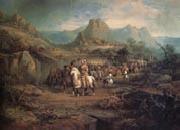 |
John Mix Stanley
|
|
A famous painter of Indians and Indian scen .
American , 1814-1872
American , 1814-1872,was an American painter of landscapes, portraits and Native American life. He was born in Canandaigua, New York and orphaned at the age of 12. At age 14, Stanley became an apprentice to a coach maker. Looking for better work, he moved to west in 1832 and became a painter of signs and portraits. In spring 1843 Stanley accompanied the party of Indian agent Pierce M. Butler to the Tehuacana Creek Council. At the outbreak of the Mexican War in 1845, John Mix Stanley joined Colonel Stephen Watts Kearney's expedition to California and produced many sketches and paintings of the campaign. He traveled to Hawaii in 1848 and spent a year painting portraits of members of the royal family. He traveled across the Isthmus of Panama in 1853. He also painted Comanche warriors in their natural environment. He moved to Detroit in 1864 and remained there for the rest of his life. Stanley helped to found a forerunner of the Detroit Institute of Arts and to incorporate the National Gallery and School of Arts. Stanley's primary interests and sympathies were with the Indians. The Smithsonian exhibited his pictures, but Congress never appropriated monies for them. More than 200 of his works were destroyed in the Smithsonian fire of 1865. |
|
|
|
|
|
|
|
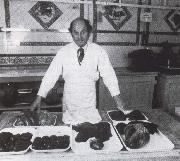 |
jonathan miller
|
|
(born July 21, 1934, London, Eng.) British director, writer, and actor. After earning a medical degree at Cambridge University, he made his professional stage debut at the Edinburgh Festival in the hit satirical revue Beyond the Fringe (1960). |
|
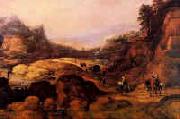 |
Joos de Momper
|
|
Flemish Baroque Era Painter, 1564-1635
known as Josse de Momper, is one of the most important Flemish landscape painters between Pieter Brueghel the Elder and Peter Paul Rubens. Brueghel's influence is clearly evident in this many of de Momper's paintings.
Born in 1564 in Antwerp, Joos de Momper was first apprenticed to his father. In the 1580s, he travelled to Italy to study art. De Momper primarily painted landscapes, the genre for which he was well-regarded during his lifetime. He painted both fantasy landscapes, viewed from a high vantage point and employing a conventional Mannerist color transition of brown in the foreground to blue and finally green in the background, and more realistic landscapes with a lower viewpoint and more natural colors. His wide panoramas also feature groups of figures. Only a small number of the 500 paintings attributed to De Momper are signed, and just one is dated. |
|
|

